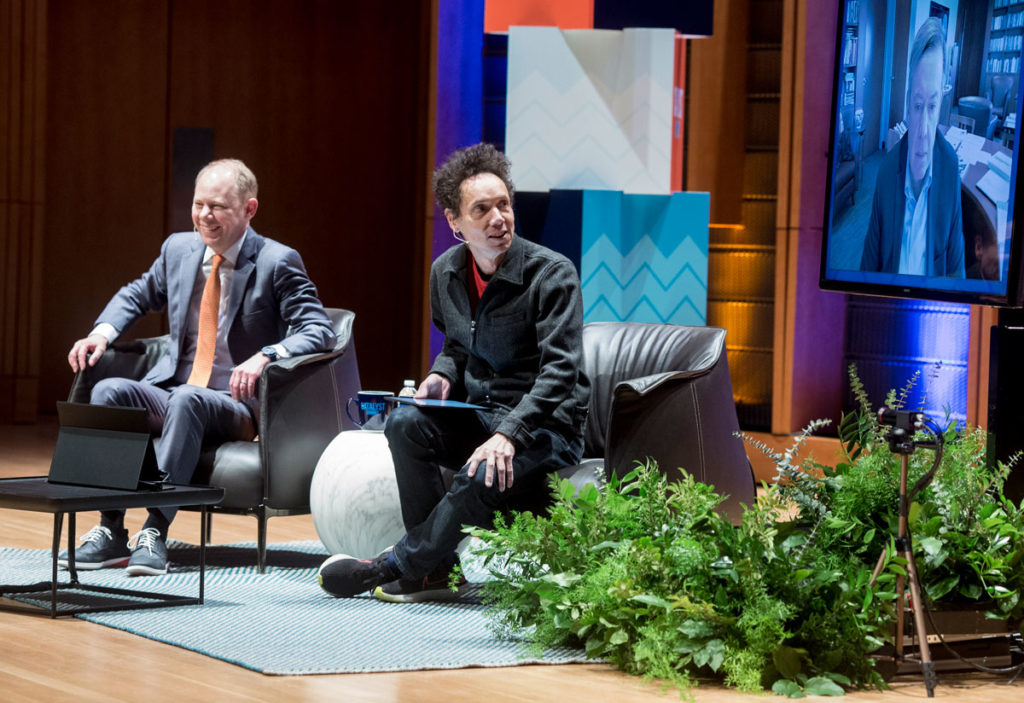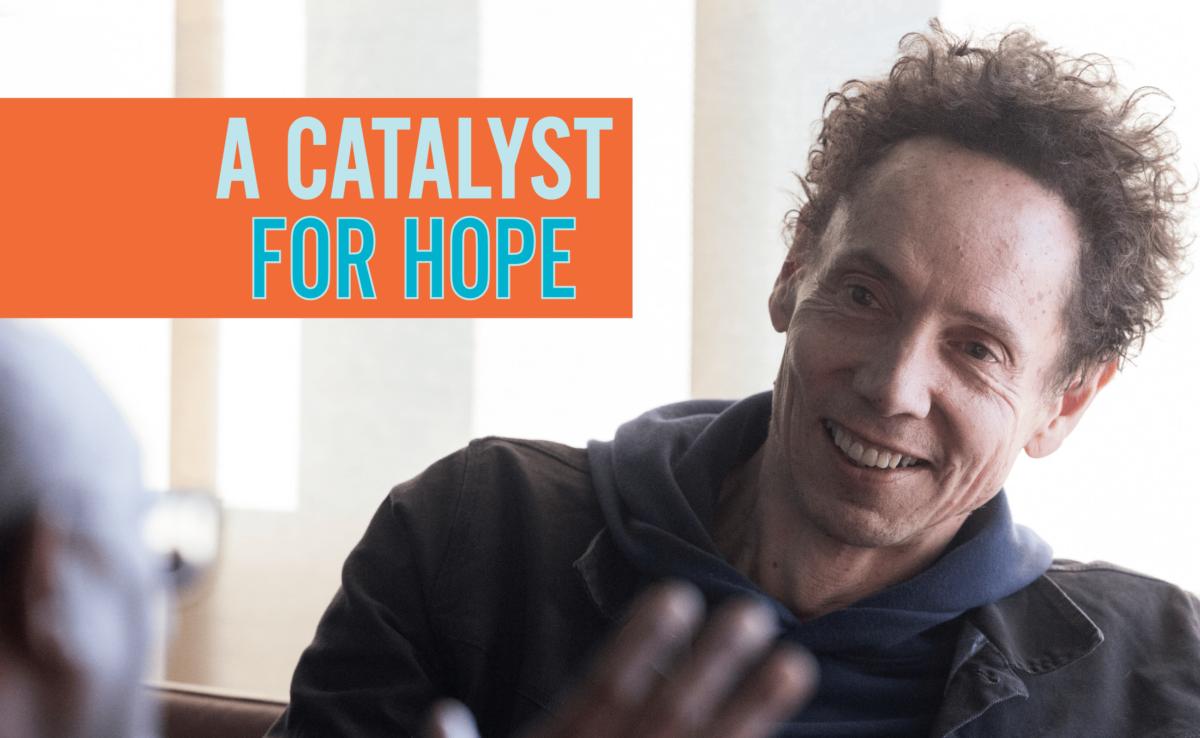A Catalyst for Hope
In the latest of his seven New York Times bestsellers, Bomber Mafia: A Dream, A Temptation and the Longest Night of the Second World War, Malcolm Gladwell, the world-renowned author, journalist and visionary thinker, draws a conclusion after researching the “Bomber Mafia,” the small but renegade band of 1930s U.S. Army pilots who sought to revolutionize the very nature of military combat.
He writes: Revolutions are birthed in conversation, argument, validation, proximity, and the look in your listener’s eye that tells you you’re on to something.
 Mr. Gladwell, could the same be said about the Hope Forward initiative, the ambitious pay-it-forward tuition model being championed by Hope College that seeks to revolutionize the very nature of higher education?
Mr. Gladwell, could the same be said about the Hope Forward initiative, the ambitious pay-it-forward tuition model being championed by Hope College that seeks to revolutionize the very nature of higher education?
 “Oh, yes,” he replies without hesitation, settling into a sofa in a Haworth Hotel conference room just hours after arriving in West Michigan for a whirlwind two days as keynote attraction for the college’s first Catalyst Summit. “I just had a conversation with five Hope Forward students who were so — not just articulate. They were more than that. They were moving, and kind of passionate. It’s really, really hard not to get inspired by that. That’s what that passage says: It’s the look in their eyes.”
“Oh, yes,” he replies without hesitation, settling into a sofa in a Haworth Hotel conference room just hours after arriving in West Michigan for a whirlwind two days as keynote attraction for the college’s first Catalyst Summit. “I just had a conversation with five Hope Forward students who were so — not just articulate. They were more than that. They were moving, and kind of passionate. It’s really, really hard not to get inspired by that. That’s what that passage says: It’s the look in their eyes.”
From that sampling of the 58 students from 19 different states and 11 foreign countries who make up the inaugural Hope Forward cohort, Gladwell came away with a distinct impression. “They realize that they’re part of a revolution,” he observes.
“They’ve come here and they’ve understood, ‘Hey we’re involved in this wild, crazy, kind of fantastic experiment, and if it works this will be a game changer for thousands of kids.’ If I could bottle what was in that room and take it out to the world, we could get this funded instantly. I told Matt (Hope President Matt Scogin ’02), ‘They’re better than you at this. Instead of you doing fundraising calls, you should send them out.’”



Indeed, one of the consensus highlights of the summit, subtitled “Access and Innovation in Higher Education,” attracting hundreds of attendees on campus and online March 8-9 for meaningful conversations on reversing a U.S. student debt load of $4.75 trillion and counting, was the “unveiling,” if you will, of six Hope Forward students. Hailed by presenter Nicole Dunteman, Hope Forward senior program director, as “our true stars and experts,” the program’s participants had not previously been identified so they could appreciate the full Hope experience without excessive scrutiny.
And appreciate it they have. One of the speakers, Anna, a sophomore from Louisville, is already active as a student organization leader. Seated side by side onstage at a packed Jack H. Miller Center for Musical Arts Concert Hall, all six volunteers were ready to bare their minds and souls.
“I think the biggest thing about Hope Forward is just…hope,” observes Sydney, a freshman from Iowa. “You’re giving all these families the hope they maybe didn’t think they would get. College is expensive. But for a lot of people, the hope that this is a new journey God is providing for you, and being able to give that back to people the way these generous donors have given it to us is really incredible.”
“It’s way more than a financial model… It’s generosity at its purest form. You’re receiving something I never thought I would be able to receive. But now that I have it, I can’t wait to give it to other students who may be in the same shoes I am.”
“It’s way more than a financial model,” adds Davi, a freshman from Brazil who grew up a missionary kid in Thailand. “It’s generosity at its purest form. You’re receiving something I never thought I would be able to receive. But now that I have it, I can’t wait to give it to other students who may be in the same shoes I am. What you put into it is what you get out of it, and I can’t wait to see what this will become in the future.”
But it was Steven, a freshman from Delaware by way of Dubai, who took on the question everyone was wondering. “People may think, ‘If you’re getting your tuition free, then you don’t care about your education as much,’” he speculates. “I think it’s the other way around. I think when we’re given this opportunity, we realize that we’re part of something so much greater. It’s ‘others focused,’ and I think that makes us want to do better and want to give back.”
The student panelists’ reflections on generosity realize one of the central goals of Hope Forward: namely, to foster a culture of grace grounded in the Gospel. Recalling how movingly one of their peers had also expressed the message, Gladwell noted, “It was about taking lessons straight from the scripture and saying, ‘This is something we are called to do. This is a kind of version of God’s will.’”
The role of the Christian faith — not only in underpinning Hope Forward but as an exemplar beyond — was woven throughout the summit’s presentations. As Scogin explained, “We believe everything we have is a gift from God, and the only appropriate response to that is to be generous, is to be grateful, is to give.”
The conversations across March 8 and 9 considered not least of all how that message can inspire and shape society, particularly at a time when religiosity and church engagement are on the decline nationwide.
“I think communities like this that have been informed by essentially 2,000 years of a tradition that is steeped in gift and notions of forgiveness and what it is to receive first — that then generates certain types of lives and transformation,” said featured speaker Anne Snyder, editor-in-chief of Comment magazine, the Christian-based publication devoted to strengthening and improving our societal institutions. “This place, which is an academic institution that is rooted in that old stream — if you can embody it again in this communal way, having a lot more of this out there in civil society broadly I think is a way to create this sort of whole other set of rivers.”
It was another best-selling author, Michigan-based Mitch Albom, who served as unlikely matchmaker between Hope Forward and Gladwell. Albom, who made an appearance at the Catalyst Summit, agreed early on to provide funding for four students for the initiative. “And while talking to Mitch one day,” Scogin recalls, “he suddenly said, ‘You know, I think my friend Malcolm Gladwell might be interested in this. Do you mind if I tell him about it?’”
“It’s a gamble, but it’s a great gamble. And I am just over the moon that somebody is finally trying to address these deep structural problems in higher education.”
Scogin didn’t mind. And Gladwell was interested.

But Malcolm Gladwell must receive hundreds of personal appearance requests every year. He could have “attended” the summit virtually and still given the event impact and star power. What motivated him to fly to Holland, Michigan, to explore the possibilities of Hope Forward firsthand?
“Well, it’s new,” he explains. “And different. And exciting. As you may know, I’ve been on this mini-crusade for the longest time about what ails higher education. I’ve done podcast episodes on it (on Revisionist History, his popular podcast produced by Pushkin Industries, the company he co-founded). I’ve written about it. So when I hear about new and interesting things I get curious. So I decided I should come here.
“It’s a gamble, but it’s a great gamble. And I am just over the moon that somebody is finally trying to address these deep structural problems in higher education.” Or, as Gladwell explained tongue-in-cheek to an audience at one “Catalyst Conversation” session, “I went for a walk down Eighth Street, and I saw fancy restaurants, gastropubs, fast-food restaurants, every different kind of eatery. There’s more innovation in four blocks of Eighth Street than there is in all of American higher education.”
That conversation, “Pushing the Boundaries of Innovation in Higher Education,” saw Gladwell pairing Scogin with Arizona State University President Dr. Michael Crow, who transformed ASU from America’s preeminent party school to a nationally respected institution for research, online programs and inclusion. Crow estimated it took 15 years to achieve those innovations. “We’ve been at this (Hope Forward) for 19 months,” Scogin replied, then suggested a possible reason major change in higher ed is so difficult.
“I was 39 when the Board of Trustees hired me,” he reflected. “Both Michael and I took on our jobs in the middle of our careers rather than near the end, which is the typical path for a college president. The average age of a college president in the U.S. is 62, and their average time of service is six years. If you do this job at the end of your career and you have only six years to do it, you don’t have time to set a vision, see the change, then see the institution though it.”
The Catalyst Summit galvanized virtually every segment of the campus community while giving Hope a brief but significant national spotlight. Those playing significant roles in the conference included Dr. Gerald Griffin; Hope’s provost, who participated in two sessions, “Breaking Through the Tuition Barrier” with philanthropist and HOPE Toledo founder Pete Kadens, and “Creating the Future of Learning” with Dr. Heidi Kraus, associate provost; the Rev. Dr. Trygve Johnson, the Hinga-Boersma Dean of the Chapel, who chaired an interactive discussion on “The Christian Case for Hope Forward”; Douglas Conant, former Campbell Soup Company president-CEO and Hope Trustee; Shonn Colbrunn ’94, Boerigter Center executive director; Scott Travis ’06, executive director of alumni engagement; Dr. Stephen Maiullo, interim dean for arts & humanities; and Dr. Ryan White, associate dean for academic advising and applied learning.
The surprise of the Catalyst Summit may have been the unconventional “keynote address” that closed the event Thursday evening. The stage of the Miller Center looked more like a late-night TV talk show, complete with a handcrafted “After Hours” logo, anchor desk and chairs for the celebrity guests.
However, the surprise of the Catalyst Summit may have been the unconventional “keynote address” that closed the event Thursday evening. The stage of the Jack H. Miller Center for Musical Arts Concert Hall looked more like a late-night TV talk show, complete with a handcrafted “After Hours” logo, anchor desk and chairs for the celebrity guests. Gladwell assumed the Fallon/Kimmel/Colbert role: his guests included Snyder; Dave Levin, co-founder of KIPP Public Schools, a network of 280 pre-K-12 public charter schools across the U.S. that has been in operation for 30 years, and the ubiquitous President Scogin.
“We got so many things wrong 30 years ago, so many,” Levin admitted. “I mean, we could have a whole discussion. But the thing we did get right was this idea that it was never about school. It was about life. And we decided that we were going to be here for each other, make a commitment to each other, for life.”
Sounds a lot like Hope Forward, doesn’t it?
Malcolm Gladwell’s Podcast Revisionist History

Malcolm Gladwell’s Revisionist History podcast featuring reflections and interviews from the summit will debut this summer.
Revisionist History examines things from the past and asks whether we understood them the right way the first time. Tune in!
Did you miss The Catalyst Summit and want to check it out?
Visit catalyst.hope.edu/live to watch the recorded sessions.
In Gratitude …
Special thanks to Jim McFarlin ’74 for covering the entire Catalyst Summit – in addition to hosting the event’s student panel. We are grateful to Steven Herppich for his expert photography of our event, our talented partners at Brightformat for helping create all of our stage graphics and backdrops, and Haworth Inc. for providing the guests’ furniture featured on stage.













One thought on “A Catalyst for Hope”
Comments are closed.